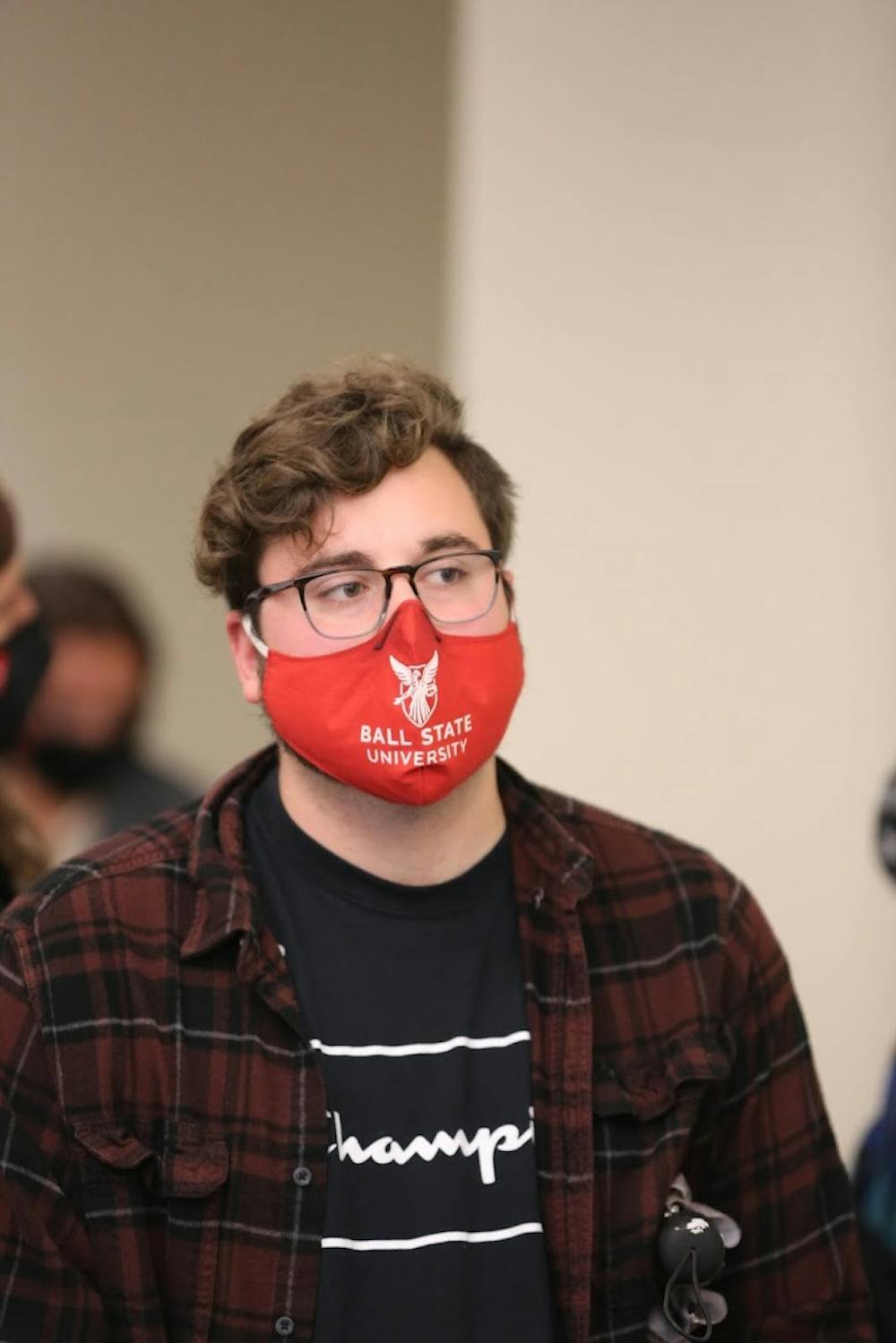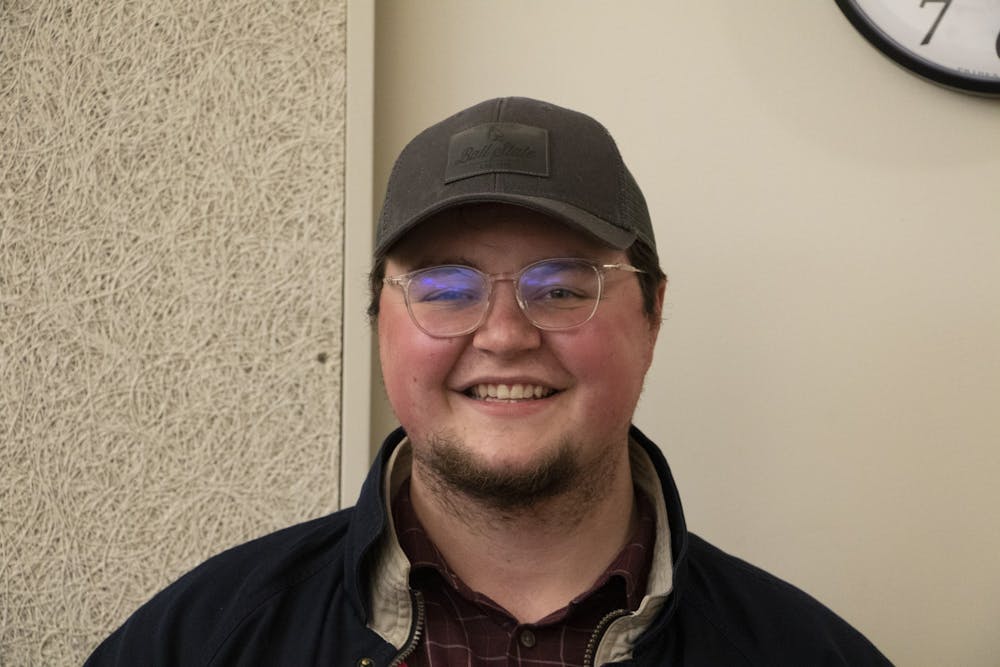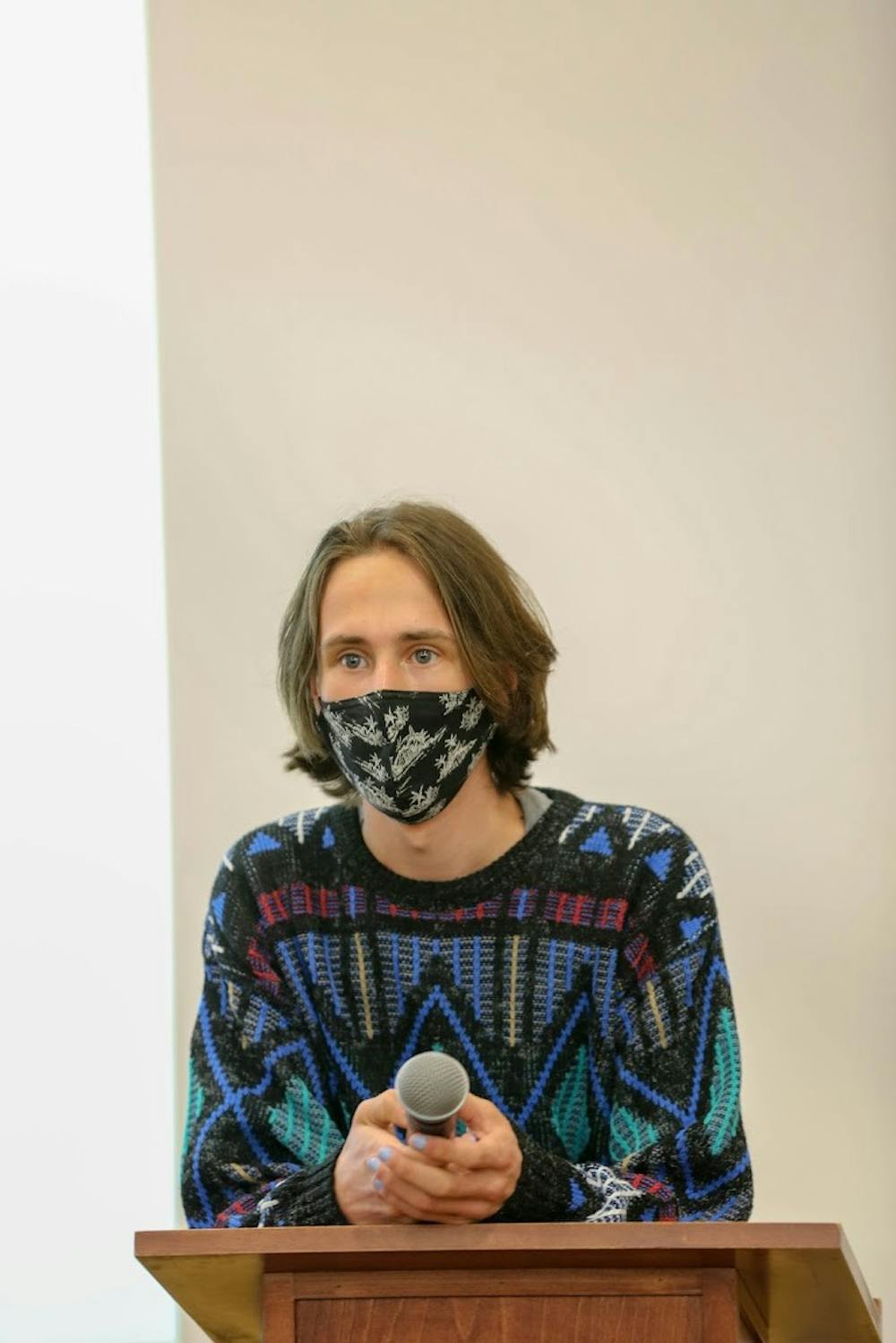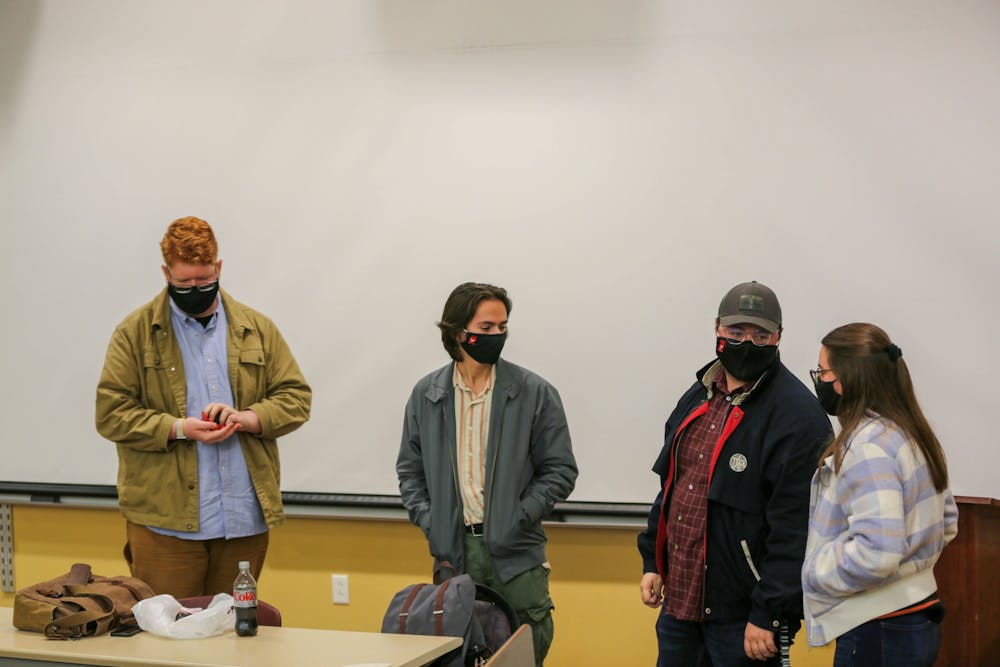For the people hear us singing
Jake Seymore, junior telecommunications major, is one of many Ball State students who has an on-campus job. Working for University Media Services (UMS) as an equipment check-out assistant, Seymore makes $7.25 an hour — the current federal minimum wage. Living in off-campus housing, affording rent, tuition and other bills have turned into daily worries for him.

Jake Seymore shares his story of living on minimum wage at the Ball State Young Democratic Socialists of America's (YDSA) town hall meeting Oct. 28. Seymore described having to sell plasma twice a week for extra cash and his daily worries about being able to afford rent and tuition. Eli Houser, DN
“To be honest with you, I’ve been skating by on a very thin thread,” Seymore said. “So, my quality of life isn’t great — I’ve had very many financial struggles and just affording bills [and] tuition is a day-to-day worry for me.”
Unable to sustain himself with his one university job, Seymore has gone down other routes to make more money.
“I donate plasma twice a week, weekly,” Seymore said. “So, I guess you could say I kind of work a second job.”
In mid-September, Seymore decided to apply for the Supplemental Nutrition Assistance Program (SNAP). However, because he was unable to work the required 20 hours per week to retain the benefits, his benefits were cut after only a single monthly payment.
“At the time, I was granted because of my financial situation,” Seymore said. “But, after my documents were looked over, at least for [September], they were discontinued because my pay stubs did not reflect a perfect 40 hours [over two weeks].”
Seymore said the reason he continues to work for UMS is it relates to his future employment goals.
“My job relates to what I want my career to be, in a certain sense,” Seymore said. “I get to examine video equipment thoroughly and, honestly, it is something I understand better than any other medium in the educational sense.”
Although he has applied for off-campus jobs to work on the weekends, Seymore said he has yet to hear back from any of them.
Seymore is one Ball State student who has expressed their support for an on-campus minimum wage increase to at least $9 an hour.
“I personally feel like this minimum wage increase is entirely necessary and has been for a very long time now,” Seymore said. “And, the fact it hasn’t been increased is, quite frankly, absurd to me.”
Hearts starve as well as bodies
The minimum wage for an on-campus job at Ball State is currently $7.25 an hour, with a cap on undergraduate student wages of $9 an hour, according to the Ball State Career Center. Undergraduate students who work on campus are also prohibited from working more than 20 hours per week.
The Ball State Daily News contacted Alan Finn, vice president for business affairs and treasurer, and Greg Fallon, chief digital marketing and communications officer, via email Nov. 5 for a comment regarding:
The process of raising the minimum wage for on-campus student workers
How many undergraduate students work on campus for between $7.25 and $9 an hour
How much it would cost the university to raise wages to $9 an hour and whether these costs would impact tuition
Whether any federal or state laws hinder the university in changing the wage or the number of hours undergraduate student employees are allowed to work
Jim McAtee, assistant vice president and executive director for career and professional development, via Andrew Walker, senior communications strategist, said in an email Nov. 6, “Departments have the flexibility to decide wages for their students and there is a process in place for them to request wages above $9 an hour for undergraduate workers.”
According to the On-Campus Student Employment Supervisor Handbook McAtee provided, “total student employment compensation, including longevity, cannot exceed $9 an hour.”
McAtee said there are 1,765 on-campus student employees making between $7.25 and $9 an hour. Of this number, he said 1,120 make between $7.25 and $7.44 an hour, 469 make between $7.45 and $8.99 an hour and 176 make $9 an hour.
Regarding the cost of raising the minimum wage, McAtee said Nov. 6, “It’s important to understand the following figures are based on the current number of student employees at Ball State, and are subject to change at any time.”
McAtee said, as of now, if on-campus student employees were to work a maximum of 20 hours per week, it would cost the university an additional $50,624.51 per week, $1,923,731 over a 38 week academic year and $2,632,474 over a 52 week calendar year.
McAtee did not provide a comment on whether these costs would impact tuition or other mandatory fees.
Ro-Anne Royer Engle, vice president of student affairs, said in an email via Walker Nov. 8, “Student wages has been a recent topic of discussion among University [stet] leadership. A working group is being convened to explore and evaluate the different position roles among student workers. The goal is to understand student worker pay bands, the responsibilities that accompany each position role and wage band, and to establish a clear set of wage protocols based on each role. The University [stet] will also evaluate the overall impact of any proposed pay scale adjustments. The goal of the working group is to develop a set of guidelines and recommendations for student position classifications and associated wages by the Fall 2022 hiring cycle.”
The Ball State Daily News responded Nov. 8 and said the university had yet to answer questions regarding the effect on tuition, why students are only allowed to work up to 20 hours per week and why the university pays on-campus student employees a minimum of $7.25 an hour. Walker also told The Daily News McAtee would answer a question regarding if Ball State students are limited to 20 hours per week by any federal or state law, but by Nov. 8, the date he promised, there was still no answer.
Walker said McAtee was still in the process of gathering this information and would provide it by Nov. 9. He also said, “the University [stet] has no additional details to share at this time.”
Walker said Nov. 9, “Despite our best efforts, we were unable to collect all of the requested information regarding [Federal Work Study guidelines] by the end of today.” However, Walker said McAtee could provide this information if The Daily News would extend its deadline.
The Ball State Daily News said, in an email Nov. 10, the information could be included as an update to the online article but the print deadline of Nov. 10 would remain the same.
Michael Myers, director of the Youth Employment and Wage & Hour divisions at the Indiana Department of Labor, said in an email Nov. 8, “There are no restrictions in either Indiana state or in federal law that restricts the number of hours any student may be allowed to work” and these restrictions “are instilled by the university.”
Andrew Haines, junior telecommunications and journalism major and member of the Ball State chapter of the Young Democratic Socialists of America (YDSA), said students are rarely afforded the opportunity to consistently work their maximum amount of hours.

Andrew Haines, junior telecommunications and journalism major and member of the Ball State chapter of the Young Democratic Socialists of America (YDSA), poses for a portrait Oct. 28 during YDSA's town hall discussing the undergraduate student minimum wage on Ball State's campus. Haines has been a member of YDSA since the spring 2021 semester. Joey Sills, DN
“[The university doesn’t] guarantee any consistent hours,” Haines said. “So then they’re like … ‘Maybe you’ll work six hours one week and then you work the full 20 the next week.’”
YDSA has made it its year-long mission to petition the university to raise the minimum wage, raise the cap on wages and increase the number of hours students may work.
YDSA has specifically pointed to the on-campus minimum wages of other universities to make its point. Indiana University (IU) and Indiana University-Purdue University Indianapolis (IUPUI), for example, pay their on-campus student employees a minimum of $10.15 an hour, according to IU Human Resources and IUPUI Office of Student Employment.
In 2018, Indiana State University (ISU) raised its on-campus minimum wage to $8.40 an hour “to remain competitive with hourly pay rates being offered by community agencies and employers who hire students, and to help students meet their financial demands,” according to the ISU Student Employment Wage Guidelines.
“You have these on-campus minimum wages [at other universities] that are way higher, and so we realized that it’s really unfair,” Eddie Osburn, senior English creative writing major and YDSA president, said. “I just [feel] like our minimum wage is so much lower when it definitely could, and should, be a lot higher than it is.”
Despite its name, Haines said YDSA is trying to reach out to students regardless of whether they identify as socialists.
“What a lot of people don’t realize is that they get taken advantage of every day in any aspect — no matter where you’re working, you’re probably being taken advantage of,” Haines said. “No matter what your political alignments are, you’re going to run into that.”
It is bread we fight for
The current student interest in raising the on-campus minimum wage has its roots in a former Ball State organization called the Progressive Student Alliance (PSA). The PSA was originally founded in 2015 as Students for Bernie Sanders, but was quickly denied official organization status by Ball State administrators until it could find a cause that would last longer than the 2016 United States presidential election, according to a Daily News article.
During summer 2016, it rebranded as a group advocating for progressive politics in general, with a special interest in the Sanders campaign. The group soon made a name for itself by investigating a $3.25 million donation by alumnus “Papa” John Schnatter and the Charles Koch Foundation. According to a Daily News article, the organization and many other students were concerned the donation would come with strings attached and the new entrepreneurship curriculum named after Schnatter would propagate the conservative-libertarian political beliefs associated with the Koch brothers.
In 2019, the PSA shifted its focus to raising the on-campus minimum wage and released a petition Oct. 13 for an increase to between $8.40 an hour and $10.40 an hour.
According to the PSA, the current minimum wage is a poverty wage “for many people … meaning the money they make from their job does not cover their basic needs and guarantees poverty.”
The petition the group created advocated for a redistribution of funds from areas of the university budget such as administrative salaries, construction projects, advertising and free student sports tickets.
Parker Abrell, junior political science and English major and member of YDSA, recalls seeing QR codes posted around campus his freshman year linking to this petition. Griffin Green, senior public history and philosophy major and president of the Ball State Democrats, also remembered seeing these QR codes.

Griffin Green, president of the Ball State Democrats, said he supports the Ball State Young Democratic Socialists of America (YDSA) in its efforts to raise the on-campus undergraduate student minimum wage. Green was previously a member of YDSA and has consistently supported a raise to the minimum wage since his time there. Joey Sills, DN
“It seemed like that was gaining traction,” Green said. “But right when the word started to spread … COVID hit and so, it immediately got tanked.”
It was at the height of the pandemic that YDSA was founded in early 2021. The first meeting was held virtually Jan. 26, and, even then, Osburn cited a need to raise the on-campus minimum wage.
Green, who was then a member of YDSA, was pictured on the organization’s Instagram page creating a poster emphasizing the need to raise the wage at the first in-person meeting April 8.
On Sept. 26, YDSA posted a series of pictures on Instagram explaining the need for Ball State to raise the on-campus minimum wage. This post received noticeably more likes than the organization’s previous posts — the 430 likes it received was a large outlier compared to the account’s 20-30 likes per-post average.
The post linked to the previous PSA petition, so YDSA is unsure of the number of signatures it has gotten. Osburn said their organization is interested in creating a petition of its own, but they were hesitant to give a specific time frame.
Since the resurgence of this petition, members have spent a considerable amount of their time recruiting members and building a grassroots movement. Aside from the group’s meetings focusing on the minimum wage issue, YDSA also holds a number of political education meetings, during which they discuss the book “The ABCs of Socialism” by the socialist magazine Jacobin.
“This is the basis of many socialist acts,” Osburn said. “If we as students work together, we can put pressure on the university to make change.”
We fight for roses too
According to the U.S. Department of Labor, the federal minimum wage has been $7.25 an hour since July 24, 2009. The twelve-year stretch between then and now has been the longest period without an increase to the minimum wage since it was established by the Fair Labor Standards Act in 1938, according to the Economic Policy Institute.
Supporters of raising the minimum wage often cite an increase to $15 an hour, with the nationwide “Fight for $15” political movement growing slowly in popularity since 2012 — so much so that President Joe Biden is backing it, according to his website’s policy proposals.
However, YDSA is petitioning the university for a $9 minimum wage on campus rather than a $15 one. Osburn said YDSA still supports the Fight for $15 movement but believes asking the university for more than $9 an hour would lessen their chances of making a difference.

Eddie Osburn, president of the Ball State Young Democratic Socialists of America (YDSA), opens a town hall discussion on Ball State's on-campus undergraduate student minimum wage Oct. 28. Osburn has supported a raise to the minimum wage at least since YDSA's founding in January 2021. Eli Houser, DN
“Nine dollars is not the ideal — not at all,” Osburn said. “Nine dollars, for us, is the bare minimum. If we get $9 an hour, that means we’re on par with the rest of the universities — but we want to be better than them, too.”
Abrell compared the concept of the minimum wage to the “bread and roses” philosophy — the increase to $9 an hour is their bread, with the $15 an hour ideal being their roses.
“Bread [is] the bare basics, but roses are the nice things as well,” Abrell said. “So, that’s what we’re going to fight for first before we move our attention onto those roses.”
Osburn, who works in UMS, said it’s important Ball State raise its minimum wage because not every student is able to work off-campus for multiple reasons.
“It isn’t the reality of every student that working off-campus is possible,” Osburn said. “It is a lot harder to work off-campus when you consider transportation, scheduling issues and many other things that the university helps account for in its on-campus jobs.”
They also said many students who work off-campus still find themselves in need of another job to cover basic living expenses.
“There is another significant number of students — including some of my own co-workers — who hold two jobs, one off-campus and one on-campus,” Osburn said. “These students have to have two jobs because both on- and off-campus jobs don’t pay enough for them to pay rent, pay groceries and other basic living necessities.”
A sharing of life’s glories
The effect of the COVID-19 pandemic has been a major influence on the way Americans view their relationship with capital and their value as a worker, Abrell said.
“This pandemic … has kind of given workers the time to see, 'Oh, I can do so many other things with my time,’ and have therefore increased the value of their time,” Abrell said. “And so, I think part of the reason we’re seeing this labor shortage … is because we’re seeing a renaissance in the value of leisure and the value of our workers.”
Although students have been discussing an increase in the minimum wage since at least 2019 when the PSA began its petition, the pandemic has especially incited calls for a raise, Green said — especially now that life is going back to a relative normal.
“During a pandemic, they’re making all sorts of budget cuts, there’s no way that asking for more money would’ve survived,” Green said. “But, now that … things seem to be improving, I think a lot of people are saying ‘Hey, we’ve been worked to death, especially over a pandemic — why aren’t we being paid more?’”
Abrell and Haines believe, although these ideas have been building in popularity for several years, the pandemic has been a major catalyst in making the modern progressive movement more mainstream than it’s ever been.
“I think the pandemic has opened up that can of worms that corporations are honestly really good at hiding,” Haines said.
Abrell said the recession that immediately resulted from the pandemic has exposed cracks in what he said is the “bootstraps” myth that symbolizes the American dream.
“If you’re pulling yourself up by your foot, you’re going to fall over,” Abrell said. “[The workers] are switching the American dream to one more like, ‘We need the bitter basics to then achieve that success.’”
Bread and roses
Haines isn’t entirely certain whether Ball State will listen to its students and raise its on-campus minimum wage — being a senior, he’s even more uncertain whether he’ll see such a raise in the time he has left in college, but he said he isn’t just fighting for himself.
“Even if we make this happen post us graduating, I feel great,” Haines said. “I don’t even care if I [get] to celebrate the $9 an hour — I’m just happy other people can finally get there.”
Abrell said, regardless of how long it takes, YDSA won’t stop fighting for what it feels every student deserves.
“No matter the odds, we’re going to be behind this effort,” Abrell said.
Although the raise YDSA is asking for doesn’t represent its ideal vision, Seymore said it would still greatly impact his life.
“Any kind of raise to my wage, I know will make my financial life a lot easier,” Seymore said. “All I really want is to get out of the hole that I’m stuck in right now.”
Contact Joey Sills with comments at joey.sills@bsu.edu or on Twitter @sillsjoey.





